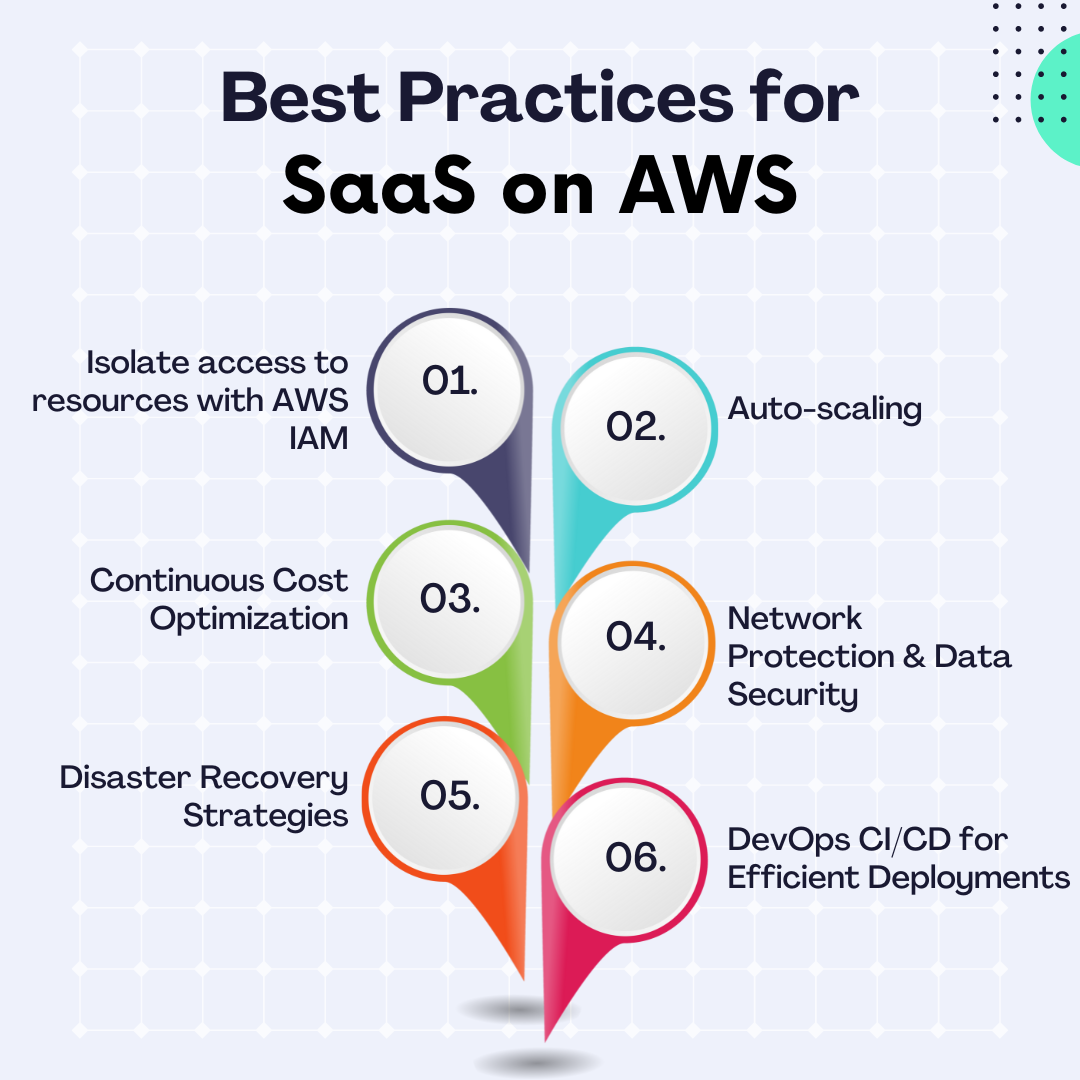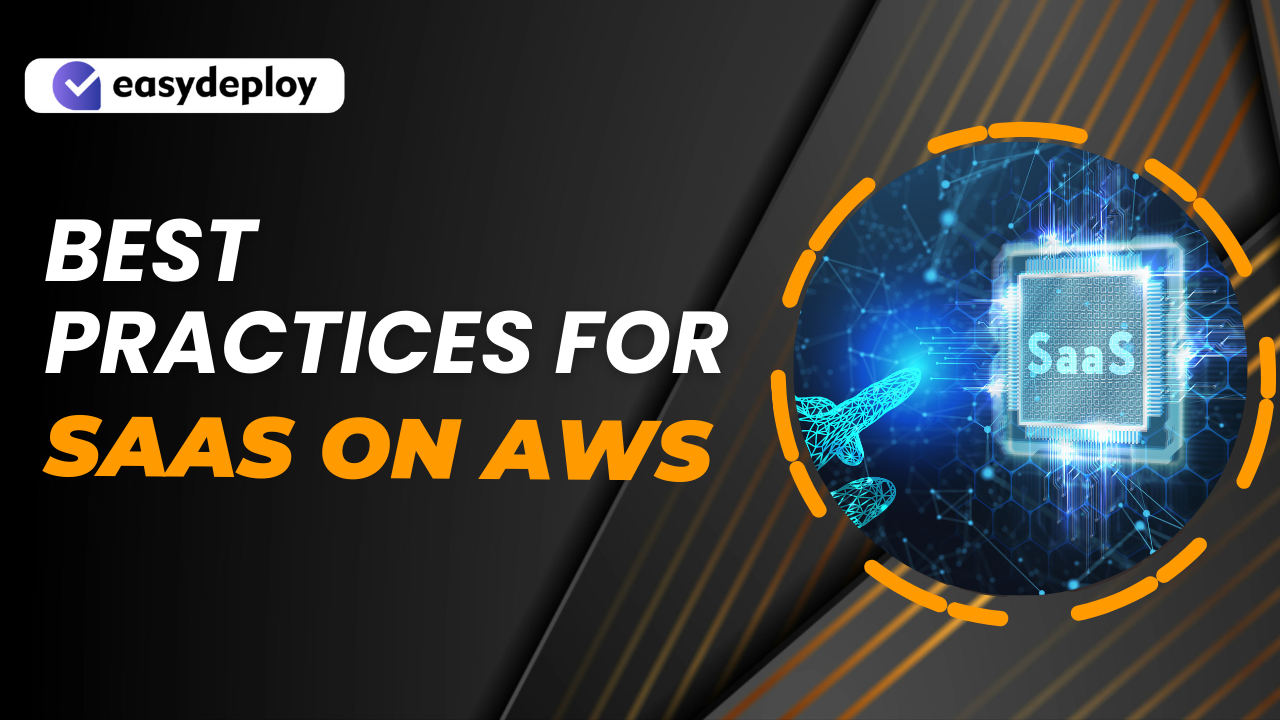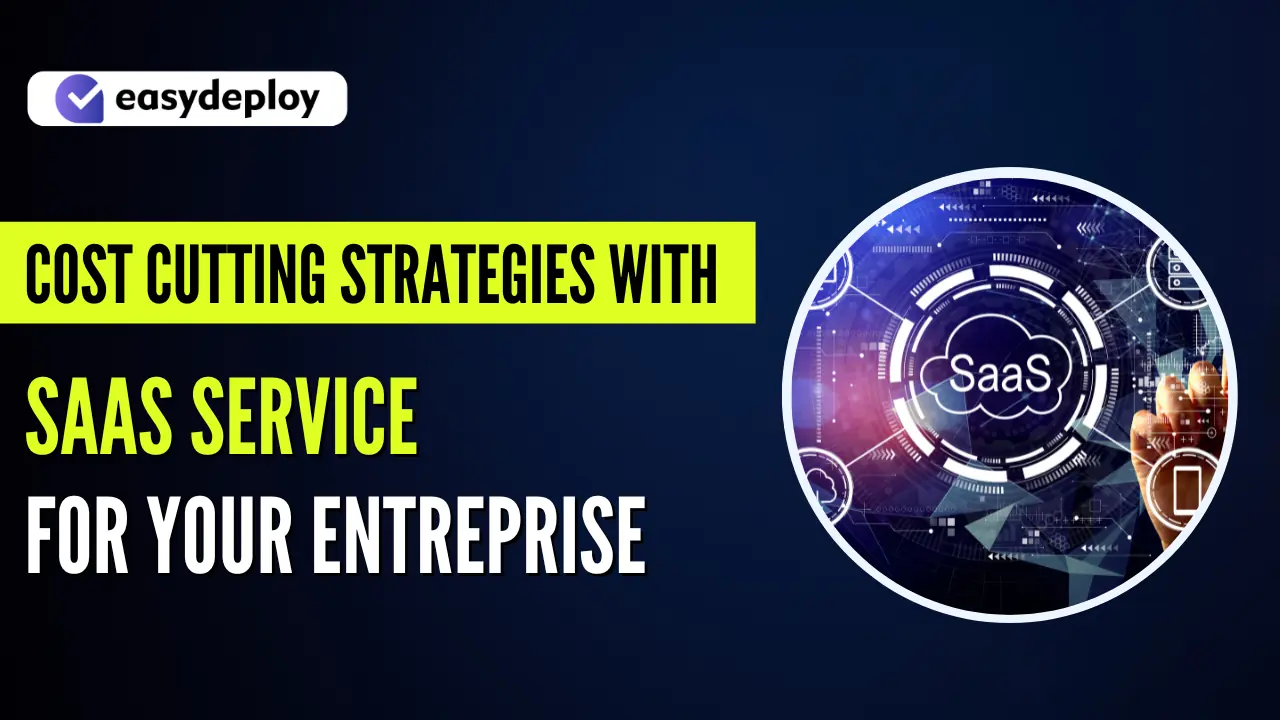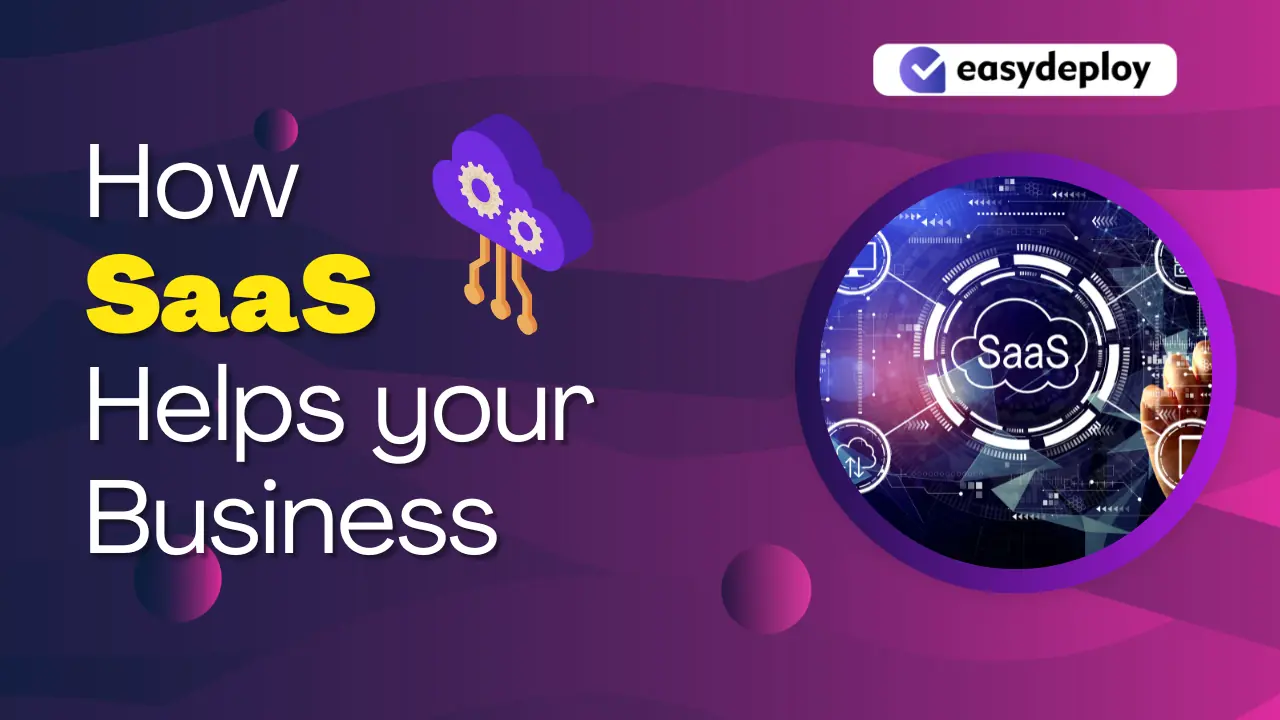In the flourishing landscape of the Software-as-a-Service (SaaS) market, businesses are increasingly driven to find the most advantageous platforms for hosting their applications, aiming to sustain a competitive edge.
Amazon Web Services (AWS) stands out as the preferred platform, showcasing an impressive track record in hosting SaaS industry leaders such as Adobe, Slack, and Atlassian.
This article will delve into the diverse advantages of migrating your SaaS application to SaaS on AWS and briefly about the best practices you must adhere to while moving SaaS on AWS.
Let’s dive in!
Why SaaS on AWS?
Creating a Software-as-a-Service (SaaS) application from the ground up can be both costly and complex. A practical approach to mitigate these challenges is to build the development project on the foundation of an already established cloud provider.
Migration of the SaaS to the AWS Cloud can yield various benefits such as improved scalability, enhanced performance, and cost-efficiency. However, it needs careful consideration and execution to achieve a smooth transition.
Transitioning a Software-as-a-Service (SaaS) platform to Amazon Web Services (AWS) brings forth numerous benefits across various dimensions. Let’s explore this in detail:
SaaS-Specific Features
AWS offers tailored features for SaaS companies, including multi-tenancy support, enabling multiple customers to share a single application instance, thereby reducing infrastructure costs. Elasticity on AWS allows automatic scaling of applications in response to demand fluctuations, ensuring optimal performance during peak usage without impacting the user experience.
The AWS SaaS Factory provides direct access to insights, expertise, and resources specific to SaaS, covering critical aspects like tenant isolation, data partitioning, and identity management.
Utilizing Amazon Aurora, a fully managed relational database compatible with MySQL and PostgreSQL, alleviates administrative burdens associated with tasks such as setup, patching, and backups.
Total Cost of Ownership Calculation with AWS
Utilize the AWS calculator to estimate costs for service configurations based on specific AWS services, app usage details, and cost per service and service group. This tool assists SaaS mobile app development experts in budgeting and planning.
Proof-of-Concept Testing on AWS
Conducting a proof-of-concept is crucial for startups before launching new features or app upgrades. AWS provides a range of services and functionalities for seamless integration, allowing startups to develop and test solutions with minimal resource commitment.
Data Protection Compliance on AWS
Addressing data protection regulations, especially across global boundaries, is simplified with AWS cloud-based SaaS application development. AWS is designed to manage global laws and privacy requirements, facilitating compliance for startup owners.
Global Market Reach through AWS Regions
AWS Regions offers global coverage of cloud computing services, enabling easy global deployment of applications without the need for multiple data centers. Building a SaaS on AWS allows strategic placement of infrastructure closer to the target audience, reducing latency and improving response times. This feature enhances the global market reach for startups.
Pay-As-You-Go Pricing
AWS SaaS adopts a flexible pay-as-you-go pricing model, eliminating upfront expenses and long-term commitments. This approach empowers businesses to scale resources based on actual usage, ensuring effective cost control.
Unlike traditional models requiring upfront license purchases, AWS allows businesses to seamlessly add or remove users as needed, ensuring payment only for the consumed resources. The SaaS delivery model on AWS reduces costs related to hardware and software maintenance, contributing to overall cost savings.
More Agility, Less Management
AWS facilitates rapid provisioning of resources, enabling SaaS companies to swiftly respond to changing demands and scale applications on demand.
By relying on a cloud-managed service provider like AWS, SaaS companies can allocate more time and resources to innovation, simplifying IT management needs. The serverless architecture of AWS Lambda eliminates the need to provision or manage servers, allowing developers to focus on application development without infrastructure concerns.
More Security, Less Friction
AWS provides robust security features, including Identity and Access Management (IAM) for controlling resource access and preventing unauthorized entry. Amazon CloudTrail offers a comprehensive record of all activities in an AWS account, facilitating monitoring for suspicious or unusual behavior.
AWS Web Application Firewall (WAF) and AWS PrivateLink enhance security by safeguarding against common web application attacks and establishing secure connections between virtual private clouds and SaaS applications.
Serverless Architectures
Serverless architectures, exemplified by services like Amazon Aurora Serverless, contribute to cost optimization by billing only for consumed resources. These architectures empower developers to concentrate on coding instead of managing infrastructure, thereby reducing operational costs and automatically scaling to meet demand.
AWS Lambda, integral to the serverless approach, proves versatile and suitable for various SaaS use cases, including event-driven processing, real-time stream processing, data analysis, and machine learning, offering quick provisioning and automatic scaling.
Time efficiency
Deploying a SaaS on AWS Cloud offers time efficiency through various means:
- Simultaneous Application Deployment: Applications can be deployed simultaneously across multiple regions and zones, ensuring a streamlined and efficient process for global availability.
- Elimination of On-Premises Hardware Setup: There is no need for the installation and configuration of on-premises hardware and IT infrastructure, eliminating time-consuming tasks associated with physical setup.
- Seamless Access Anytime, Anywhere: AWS Cloud provides seamless access to cloud applications and resources for AWS users, regardless of time or location, enhancing overall efficiency and reducing potential downtimes related to geographic constraints.
- User-Friendly Cloud Platform: The AWS Cloud offers a user-friendly platform with a smaller learning curve, expediting the onboarding process for IT teams and end-users.
These factors collectively enable SaaS companies to allocate less time to application deployment and maintenance. Consequently, IT teams can redirect their efforts towards handling other operational tasks.
Best Practices for SaaS on AWS

Here are some best practices you can follow while migrating SaaS on AWS:
Isolate access to resources with AWS IAM
Access to resource isolation can be made possible with the usage of AWS IAM. You can achieve fine-grained access control by switching to AWS Identity and Access Management (IAM). With the help of it, you can define granular permissions for individuals, to ensure that users or systems have only access to resources needed for the specified tasks. It can reduce the risks of illegal access and maintain a secure IT environment.
You can also assign IAM roles for the EC2 instances and AWS services to achieve dynamic and secured accessing management. It is possible to assign the roles to lambda functions, users, and instances, which ensures a flexible and scalable secured model.
Auto-scaling
Auto-scaling can be enabled to adjust the demanding computing resources. The number of computing resources can be scaled as per the demands, which in turn results in high availability. This elasticity ensures that your application can handle the varied workloads to achieve optimal performance during the peak period and minimize costs during less-demand periods.
To improve fault tolerance and improve system scalability, elastic load balancing disperses the incoming traffic from applications across multiple instances.
Continuous Cost Optimization
At EasyDeploy, we actively assist SaaS customers in the ongoing monitoring and optimization of their architecture to enhance both cost efficiency and performance. Our approach involves utilizing essential services like Amazon CloudWatch and AWS Config to meticulously monitor resources and applications.
Through the implementation of alerts and the utilization of application monitoring tools such as AWS X-Ray and AWS QuickSight, we ensure a fine-tuned optimization strategy that effectively balances cost considerations without compromising system performance.
Network Protection and Data Security
Ensuring the security of SaaS solutions is of utmost importance to us at Ibexlabs. We employ robust services such as AWS WAF and Shield to diligently monitor and filter traffic, effectively mitigating potential Distributed Denial of Service (DDoS) attacks.
Additionally, we prioritize comprehensive data security by implementing encryption measures at every layer—both during transit and at rest. AWS Key Management Service (KMS) plays a crucial role in this aspect, guaranteeing the safeguarding of applications and customer data.
Disaster Recovery Strategies
Our approach to disaster recovery involves the implementation of resilient and robust strategies. We achieve this by setting up replication across multiple availability zones, ensuring not only high availability but also seamless business continuity in the face of failures or outages. This proactive disaster recovery framework is designed to minimize disruptions and maintain consistent service delivery.
DevOps CI/CD for Efficient Deployments
To streamline deployments and establish a seamless multi-environment setup, Ibexlabs relies on cutting-edge DevOps practices, specifically Continuous Integration/Continuous Deployment (CI/CD).
Leveraging AWS developer tools such as AWS CodeCommit and AWS CodePipeline, we facilitate efficient source code management, automated builds, and the continuous release of new features and bug fixes. This approach minimizes downtime, enhances deployment efficiency, and aligns with modern development practices for optimal results.
Conclusion
Undoubtedly, Software-as-a-Service (SaaS) stands out as an excellent choice for businesses, offering cost and time savings while allowing staff to redirect their focus to other crucial tasks. AWS, coupled with EasyDeploy Platform, presents a diverse array of SaaS applications, ensuring you’ll discover one that aligns with your specific needs. When selecting from AWS’s SaaS services, it’s essential to weigh your business’s particular requirements and budget.
If uncertainty persists regarding the ideal service for your needs, seeking advice from our expert is recommended.
The rising popularity of SaaS, attributed to its numerous benefits, makes it a compelling option for businesses contemplating outsourcing their IT infrastructure. Therefore, a thorough examination of SaaS merits careful consideration.







